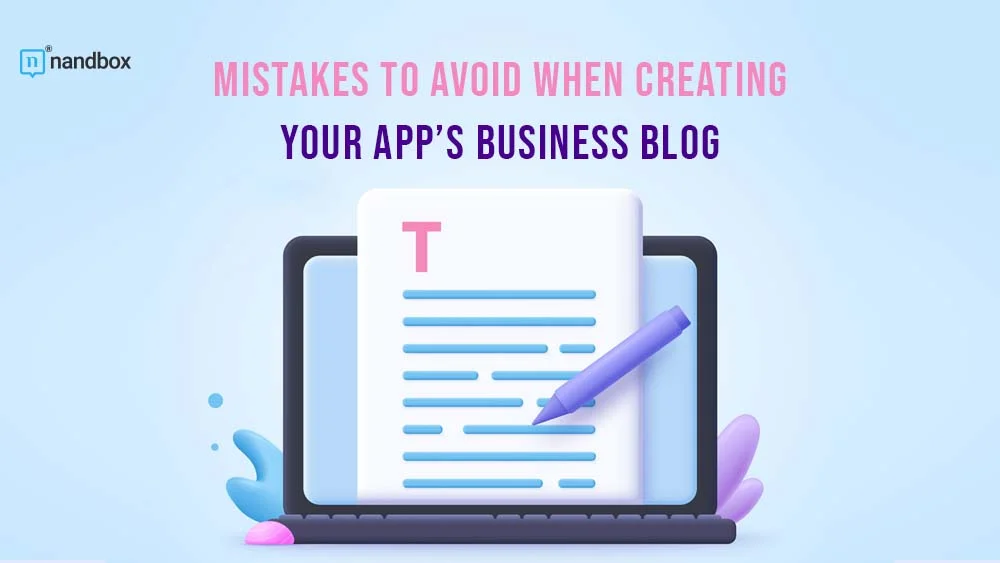The Ultimate Guide: How to Avoid Critical Mistakes in Your App’s Business Blog
In today’s fast-paced digital world, having a business blog for your app is no longer a luxury; it’s a necessity. A well-crafted blog can be a powerful tool for attracting and engaging customers, establishing your app as an industry leader, and ultimately driving business growth. However, creating a successful blog is not without challenges. From inconsistent content to poor optimization, critical mistakes can hinder your blog’s potential and have a negative impact on your app’s overall success.
But fear not! In this ultimate guide, we will explore the most common mistakes made by app owners in their business blogs and provide you with actionable tips and strategies to avoid them. Whether you’re a seasoned blogger or just starting out, this guide will equip you with the knowledge and insights needed to create an effective blog that not only captivates your audience but also helps your app thrive in the competitive digital landscape. So, let’s dive in and discover how to steer clear of critical mistakes in your app’s business blog!
App Blog: The Importance of a Business Blog for App Success
A business blog is a vital component of any app’s marketing strategy. Let me tell you exactly why that is. A blog serves as a platform to showcase your app’s expertise, connect with your target audience, and drive traffic to your website.
A well-maintained blog can help with several things. A blog can establish your app as a thought leader in the industry, build trust with your audience, and generate leads. However, many app owners underestimate the impact a business blog can have on their app’s success. They may view it as an afterthought or fail to allocate sufficient resources to its development and maintenance. As a result, they miss out on the numerous benefits that a well-executed blog can provide.
To avoid this critical mistake, it’s important to recognize the value a business blog brings to your app. By investing time and effort into creating high-quality content, optimizing for search engines, and promoting your blog effectively, you can harness the power of blogging to propel your app’s success. The following are common critical mistakes in app business blogs that will help you avoid them for futuristic references.
App Blog Mistakes: Lack of Clear Goals and Strategy
One of the most common mistakes app owners make in their business blogs is not having clear goals and a well-defined strategy. Without a roadmap, it’s easy to lose focus and create content that lacks direction and purpose. This can result in a disjointed blog that fails to engage readers and achieve its intended objectives.
To avoid this mistake, start by setting specific goals for your blog. Determine what you want to achieve, whether it’s increasing brand awareness, driving traffic, or generating leads. Once you have your goals in place, develop a content strategy that aligns with them. This will help you create focused, purposeful content that resonates with your target audience and drives the desired outcomes.
Neglecting to Define and Understand the Target Audience
Another critical mistake app owners make when it comes to their business blogs is neglecting to define and understand their target audience. Without a clear understanding of who your audience is, it’s difficult to create content that resonates with them and addresses their specific needs.
To avoid this mistake, take the time to research and define your target audience. Understand their demographics, interests, and challenges. This will enable you to tailor your content to their preferences and create a blog that speaks directly to their needs. By providing valuable and relevant content, you can attract and retain a loyal audience that sees your app as a trusted resource.
Poor Content Quality and Consistency
Your blog’s content is the main key to success. Words, if not valuable, are useless. I hate to say that word, but unfortunately, I feel obliged to use it in this context. Content quality and consistency are crucial for the success of any business blog.
Yet, many app owners fall into the trap of producing subpar content that fails to engage readers and deliver value. Inconsistent publishing schedules, grammar and spelling errors, and lackluster writing can all contribute to a poor user experience and deter readers from returning to your blog.
To avoid this critical mistake, prioritize content quality and consistency. Invest in skilled writers or editors who can produce well-researched, well-written, and error-free content. You can find inspiration in insightful blog posts of bloggers like Gaurav Tiwari or Ryan Robinson. Develop an editorial calendar to ensure regular publishing and stick to it. By consistently delivering high-quality content, you can build trust with your audience and establish your app as a reliable source of valuable information.
Neglecting Basic SEO Practices
For your blog to receive organic traffic, search engine optimization (SEO) is essential. However, many app owners neglect SEO best practices, resulting in their content getting buried in search engine rankings. Without optimizing your blog for search engines, you might be missing out on valuable opportunities.
Ones that will help you attract new users and increase your app’s visibility. To avoid this mistake, familiarize yourself with SEO best practices and incorporate them into your blog’s content and structure. To find relevant keywords and include them naturally in your blog entries, conduct keyword research.
Optimize your meta tags, headings, and URLs. Additionally, focus on creating high-quality, shareable content that naturally attracts backlinks. By implementing SEO strategies, you can improve your blog’s visibility and attract a larger audience.
Failing to Effectively Market and Distribute Your Blog’s Content
Creating great content is only half the way there. If you fail to promote and distribute your blog content effectively, it’s unlikely to reach its intended audience. Many app owners make the mistake of relying solely on organic traffic, neglecting the power of social media, email marketing, and other distribution channels.
To avoid this critical mistake, develop a comprehensive promotion and distribution strategy for your blog content. Use social media to interact with your audience and share your blog entries. Create an email list, and on a regular basis, send out newsletters that highlight your most recent blog posts. You can expand your reach by forming partnerships with influential people in your field. By actively promoting and distributing your blog content, you can expand your audience and increase your app’s visibility.
Neglecting to Measure and Analyze Your Blog’s Performance
Last but not least, app owners frequently neglect to evaluate and measure the effectiveness of their blogs. Without tracking key metrics and analyzing data, it’s challenging to gauge the effectiveness of your blog and make informed decisions to improve its performance. This lack of insight can hinder your app’s growth and prevent you from optimizing your blog for maximum impact.
You can avoid this with simple steps. For example, implement analytics tools to track essential metrics such as website traffic, engagement, conversions, and bounce rates. Analyze this data regularly to identify trends, understand your audience’s preferences, and uncover areas for improvement. By measuring and analyzing your blog’s performance, you can make data-driven decisions to enhance your content strategy and drive better results.
Ignoring the Visual Appeal of Your Blog
There is a saying that states, “Eyes follow beauty anywhere and everywhere.” I believe in this saying very much. Beauty doesn’t have to be a good piece of natural scenery or a famous tapestry in a museum. It can be simple colors displayed in an appealing way. Visual appeal plays a crucial role in capturing the attention of your readers and keeping them engaged.
Neglecting the visual aspect of your blog can make it appear dull and uninteresting, causing readers to quickly lose interest and navigate away from your site or app. To avoid this mistake, make sure to incorporate high-quality images, videos, and infographics into your blog posts. By paying attention to the visual appeal of your blog, you can create a more enjoyable and engaging experience for your readers, ultimately driving more traffic and increasing user engagement.
Lack of Communication or Interaction with your App Users or Blog Readers

Engaging with your readers is crucial for building a community around your blog and keeping them coming back for more. When readers leave comments on your blog posts, take the time to respond to them and engage in a conversation. This shows that you value their input and encourages them to continue participating in discussions.
Additionally, ask for feedback from your readers and encourage them to share their thoughts and opinions. This not only helps you improve your blog but also makes your readers feel like their voices are being heard.
Finally, actively encourage discussions by posing questions or starting conversations in your blog posts. This creates a sense of community and encourages readers to interact with each other as well. By avoiding the mistake of not interacting with your readers, you can build a loyal audience and keep them engaged with your blog.
To Wrap It Up!
In conclusion, a well-crafted business blog can be a game-changer for your app’s success. By avoiding the critical mistakes mentioned above, you can create a blog that captivates your audience and helps your app thrive in the competitive digital landscape.
If you still don’t have an app that helps empower your business and strengthens your market ties, maybe it’s time you consider developing one. I know, app development sounds complicated and hard enough to make you overthink the whole idea over your third cup of coffee on a sleepless night.
The good news is that we have a no-code solution for you! Our app builder, nandbox, will help you create seamless apps from scratch in a very easy and hassle-free manner. Sign up now and get your business to the top with nandbox’s native no-code app builder!





